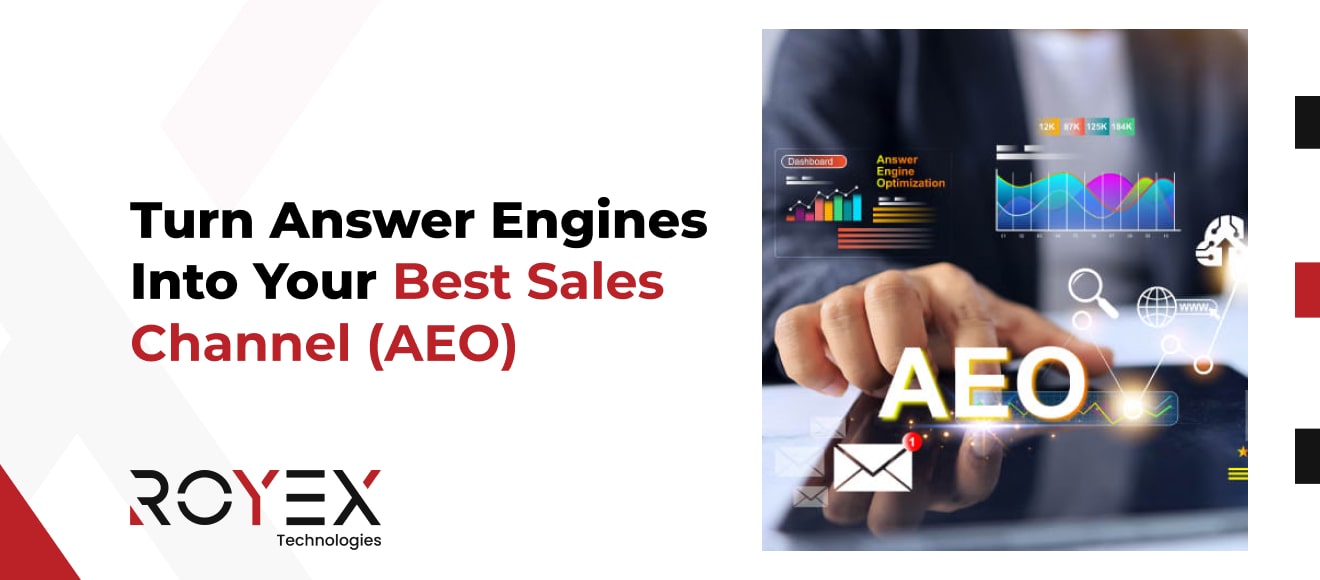
Turn Answer Engines Into Your Best Sales Channel (AEO)
For two decades, the digital customer journey started with a blue-link results page. Brands fought for keywords, meta tags, and backlinks to win visibility on Google—and then worked hard to convert cold, comparison-shopping traffic into leads. That playbook is being rewritten in real time. Consumers now ask answer engines—ChatGPT, Gemini, Perplexity, and others—for researched, cited, and contextualized guidance. They use these tools to explore options, compare vendors, validate risks, and even draft RFQs before they ever click a website. When they do visit you, they arrive warm, pre-qualified, and primed to convert.
This shift creates both a threat and an outsized opportunity. The threat: if your brand is absent from AI answers, your top-of-funnel disappears. The opportunity: if you optimize for answers (AEO), you can transform answer engines into your most effective sales channel—one that sends you high-intent, high-close-rate demand.
Below is a practical, end-to-end guide to AEO: why the shift happened, what the data says, what leaders are saying, and how to architect content, data, and systems so answer engines consistently cite you, recommend you, and send you customers.
From “blue links” to “best answers”: what changed?
The traditional path (SEO → click → research → lead)
- Discovery happened on Google. Your job was to rank, earn a click, and then nurture on-site with long-form pages, comparisons, CTAs, and lead magnets.
- Friction was part of the process: users opened multiple tabs, stitched information together, and only then filled a form or booked a call.
The new path (AEO → trust in chat → decisive click → sales interaction)
- Discovery and research now happen in the chat box. Users ask for “best options,” “trade-offs,” “step-by-step,” and “who should I talk to,” and the answer engine synthesizes sources, adds context, and names brands with citations.
- Clicks are fewer but warmer. When people finally visit a site, they’ve already compared alternatives, seen your differentiators, and often copied a checklist or brief from the AI. These AI-assisted leads close faster because intent crystallized before arrival.
This isn’t speculative. Several independent signals show the center of gravity moving from traditional search to AI answers:
- Gartner projects a 25% drop in traditional search engine volume by 2026 as AI chatbots and virtual agents substitute for many queries. Gartner
- ChatGPT processes 2.5+ billion prompts per day (≈912.5B/year), with accelerating adoption. The Verge
- In Adobe’s May 2025 survey of U.S. users who use ChatGPT as search, 77% use it as a search engine, 24% start there first, 30% trust ChatGPT more than search engines, and 36% discovered a new brand/product via ChatGPT. Adobe
- An AP-NORC poll found 60% of U.S. adults use AI to search for information—with usage highest among under-30s—showing the behavioral mainstreaming of AI search. AP News
- Perplexity, the AI-native answer engine, reported 780 million queries in May 2025 (+20% MoM), and a runway toward 1B weekly queries, underscoring that “answers-first” search is scaling fast. Search Engine Land
The platform leaders themselves are explicit about this transition:
- Sundar Pichai: Google Search will “change profoundly” (2025), with AI modes that directly address complex queries. The Verge+1
- Bill Gates: “Agents will replace search sites because they’ll be better at finding information and summarizing it for you.” Gates Notes
- Satya Nadella describes an “agent era” where classic applications and workflows collapse into AI-mediated experiences. Medium
- Jensen Huang (NVIDIA) uses ChatGPT, Gemini, and Perplexity daily as tutors and frames AI as transforming how everyone accesses information—all jobs will be reshaped by AI. Business Insider
- Aravind Srinivas (Perplexity) calls this shift the move from web indexes for clicking to indexes for AI that produce grounded answers. The Economic Times
Why answer-engine traffic converts better
Conversation builds trust
Answer engines let buyers ask follow-ups (“what’s the failure rate?”, “any UAE-specific regulation?”, “compare vendor A vs B”). The AI cites sources and reconciles conflicts. Trust forms before the click—so when buyers visit, they are predisposed to act.
Contextual grounding & citations
Platforms like Perplexity emphasize real-time web retrieval with citations—users can verify claims instantly, reducing skepticism. Brands that become the cited source inherit that trust. Perplexity AI
Buyer enablement at the top of funnel
AI answers often include checklists, timelines, cost ranges, evaluation criteria, or even draft RFP text. Visitors arrive with a clearer scope—shortening sales cycles. (Google’s public messaging similarly stresses moving beyond information to intelligence inside Search.) blog.google
Fewer, higher-intent clicks
As Google itself adds AI overviews/modes, zero-click behavior rises. You’ll get fewer visits—but the ones you do get are buyers on a mission. (Industry analyses chronicle falling organic clicks and the risk to sites that rely on classic SEO.) Surfer SEO+1
AEO: the Answer Engine Optimization playbook
Your goal in AEO is to become the canonical, quotable, and actionable source that answer engines prefer to cite—and then to make your destination pages convert AI-warmed users with minimal friction.
Build a “single source of truth” that machines can quote
Authoritative “Answer Objects.” Convert your expertise into atomic blocks that map to real questions: What is it? Who is it for? How does it work? How much does it cost (ranges)? Implementation steps? Alternatives? Risks? Regulations? Each block should be precise, dated, and self-contained with references.
Schema & structured data. Use FAQPage, HowTo, Product, Service, SoftwareApplication, Organization, and Article schema across your site. Mark up pricing models, feature lists, supported regions, certifications, SLAs, and case studies so engines can parse them.
Transparent sourcing. Where possible, cite standards, laws, benchmarks, or third-party research right on the page—answer engines reward citation-ready pages. (Perplexity, for example, highlights answers with linked sources.) Perplexity AI
Publish content in formats answer engines already surface
Comparisons & matrices. “X vs Y,” “Which is best for [use-case/region/budget],” and “trade-offs” content gets asked constantly. Publish concise, evergreen comparison tables with clear criteria and update stamps.
How-tos and decision guides. Stepwise guides with prerequisites, timelines, and pitfalls are highly quotable.
Short, factual primers. One-screen explainers (definitions, formulas, checklists) satisfy direct questions and are easy for answer engines to excerpt.
Prepare your content for conversational retrieval
Write like you answer a question. Use headings as questions, lead with the answer, then add nuance. Keep sentences plain, include numbers and ranges, and avoid adjectives that sound like marketing.
Add explicit constraints. E.g., “For Dubai, UAE: RERA requires X; typical processing is Y weeks; compliance docs: Z”—region-specific facts are frequently requested in chat and make your page uniquely valuable.
Version and date visibly. Engines and evaluators prefer recently updated, stable content—especially for stats, prices, and regulations.
Expose machine-readable knowledge
OpenAPI + docs for your product/knowledge endpoints. If you provide a tool, API, or data service, publish clean docs and a public demo endpoint. Agentic systems can call these. (Platforms are steadily moving toward agent ecosystems.) Medium
Embeddings-friendly structure. Keep high-signal content in clean HTML (avoid burying key facts in images/PDFs). Maintain stable anchors/IDs so answers can deep-link the exact section.
Canonical URLs & source consolidation. Avoid duplicate answers across domains; concentrate authority where you want the citation to land.
Earn citations inside the answer engines
Participate natively where possible. Perplexity’s Pages let you publish authoritative, sourced explainers that the platform can surface and cite. Treat this like guest-posting inside an answer engine. Perplexity AI+1
Host “researcher-friendly” pages. Keep load time fast, no heavy pop-ups, and ensure sources referenced on your site are accessible (no paywalls or geoblocks).
Offer quotable data. Original stats, benchmarks, ROI calculators, and region-specific compliance tables are catnip for answer engines (they love structured, citable facts).
Design AI-aware landing pages to convert “warm” traffic
When an AI-educated buyer finally clicks, assume they’ve seen a synthesized overview already. Your page should:
Start at the “so what.” Put the crisp value prop, pricing cues (or ranges), implementation timeline, and proof points above the fold.
Acknowledge the journey. Add a short panel like “What ChatGPT/Perplexity likely told you” with quick confirmations and links to deeper sections.
Mini-briefs & downloadable scopes. Provide a 1-page scoping checklist (editable Google Doc/PDF) that mirrors what answer engines recommend—so the buyer can move straight into qualification.
Conversational CTAs. Offer “Ask our AI for a tailored scope”, “Chat with our engineer now”, or “Get a ballpark quote in 2 minutes.” If you can, integrate an agent that ingests the prospect’s brief and drafts a proposal.
Instrumentation, evaluation, and iteration
Track “AI-assisted” sessions. Ask politely on forms: “Did you find us via ChatGPT/Gemini/Perplexity?” Treat it as a separate source.
Measure citation share. Manually sample priority questions weekly and record if/where you’re cited in ChatGPT (with browsing), Gemini’s AI mode, and Perplexity. Optimize pages that are close but not cited.
Run answer-based content tests. Quarterly, pick 10 high-value questions, ship improved Answer Objects, and re-measure citations and leads.
The data: momentum behind AI-assisted discovery
Traditional search downshift. Gartner forecasts a 25% decline in search engine volume by 2026 as chatbots/agents answer more queries. That implies a material reallocation of marketing mix away from pure SEO toward AEO. Gartner
AI usage for search is mainstream. An AP-NORC poll shows 60% of U.S. adults already use AI to search; younger cohorts lead adoption, signaling future-proof behavior change. AP News
Generative-AI platforms are massive query sinks. ChatGPT alone handles ~2.5B prompts per day; on Google’s side, AI modes are being shipped as a “total reimagining of search.” The Verge+1
Answer-first engines are scaling quickly. Perplexity publicly shared 780M queries in May ’25 (+20% MoM), with ambitions for 1B weekly queries—evidence that “answers not links” isn’t a niche preference. Search Engine Land
Commercial implication: Adobe’s 2025 study found 36% of respondents discovered a new brand via ChatGPT, and 76% of marketers say it’s essential to appear in ChatGPT answers in 2025. This is direct evidence that answer visibility drives brand discovery and demand. Adobe
What respected leaders are saying (and why it matters for AEO)
Sundar Pichai (Google): Search will “change profoundly”—expect more complex, conversational answers inside Google itself. Translation: even if you “do SEO,” your content must be answer-ready for AI modes. The Verge
Bill Gates: “Agents will replace search sites.” Translation: your growth plan must include being the source those agents quote and supplying machine-readable facts they can act on. Gates Notes
Satya Nadella (Microsoft): We’re entering the agent era, with workflows collapsing into AI. Translation: expect fewer traditional site journeys and more AI-mediated procurement; your site must accelerate decisions, not start them. Medium
Jensen Huang (NVIDIA): Uses AI tutors daily; all jobs are reshaped by AI. Translation: your buyers are already using AI to learn and evaluate—you either feed those answers or cede the narrative to competitors. Business Insider
Aravind Srinivas (Perplexity): The future of search is indexing for AI—not for browsing. Translation: your information architecture should be designed for retrieval and citation, not just human skimming. The Economic Times
AEO tactics you can implement this quarter
Content & messaging
Create a “Top 50 Questions” library for each product/region you serve. Each answer = 150–300 words, a 1-line summary, a dated footnote with external references, and a short “How we do it” CTA.
Publish canonical “What it costs” pages. Candid ranges + factors that change price earn citations and intent.
Write decisive comparison pages that name alternatives fairly and cite third-party evidence.
Technical
Add/refresh schema at scale. Especially FAQPage, HowTo, Product/Service; ensure every page has a last-updated date and author creds.
Stabilize anchors. Use predictable id attributes for sections so answer engines can deep-link precisely to the claim they cite.
Expose a public knowledge base with versioned articles and per-article JSON (title, summary, facts, references) so agents can parse programmatically.
Distribution inside answer engines
Perplexity Pages: Publish your most authoritative guides inside Perplexity to increase your chances of being referenced. Perplexity AI
Keep sources open. If an answer engine can’t access your evidence (paywalls, blocked geos), it can’t confidently cite you.
Participate in community Q&A (Stack Overflow, GitHub, industry forums). Well-cited community posts are frequently ingested and quoted.
Conversion alignment
AI-aware LPs: Add a short “What you should know (1-minute brief)” section that echoes the top AI-summarized points.
Micro-conversions tuned to certainty: “Book a 15-min scope call,” “Get a ballpark quote,” “Download our compliance checklist.”
Sales enablement: Provide your SDRs a “Found via AI” script keyed to likely questions/objections the prospect has already explored in chat.
Metrics that matter for AEO
Citation Presence Rate (CPR): % of your priority questions where your domain is cited in ChatGPT (with browsing), Perplexity, and Gemini AI mode. Track weekly.
Warm-click Conversion Rate: Sessions where referrer or self-report indicates AI origin vs. baseline.
Answer Dwell: Time on page specifically for Answer Object pages—should be lower (they’re designed to deliver fast clarity) while conversion rate is higher.
Update Latency: Median time between a known change (price, regulation) and your content update. Lower is better; answer engines prefer freshness for volatile facts.
First-Party Reference Density: Average # of third-party references per Answer Object. Embrace verifiability.
Objections & pitfalls
“If AI answers everything, won’t clicks disappear?” Clicks will be more selective—but of higher intent. Your goal isn’t more traffic; it’s more pipeline.
“Isn’t this just SEO with new clothes?” Classic SEO optimizes for rankings and snippets. AEO optimizes for citation and confidence in a conversational setting. Your content must be structured, citable, and immediately useful inside the answer.
“Stats feel noisy.” Treat any single stat cautiously and triangulate multiple sources over time. The strategic signal is clear: executives at Google, Microsoft, NVIDIA, and leading answer engines are all pushing toward answers, agents, and actions. The Economic Times+4The Verge+4Financial Times+4
AEO checklist (keep this handy)
- Identify the 50–100 questions that define your buyer’s journey.
- Publish Answer Objects for each—short, precise, referenced, dated.
- Ship schema and stable anchors; clean up duplicate pages.
- Produce pricing ranges, comparisons, how-tos, and regional compliance pages.
- Publish a Perplexity Page (or series) for your core topics. Perplexity AI
- Instrument citation tracking across ChatGPT/Gemini/Perplexity.
- Redesign landing pages for AI-warmed visitors (briefs, micro-CTAs, fast “get a quote”).
- Iterate monthly: refresh volatile facts; add new questions seen in AI chats; retire stale claims.
The payoff: answer engines as a sales channel
As answer engines mainstream, they don’t merely “refer traffic”—they qualify demand. They compress research, sharpen problem definitions, and surface credible vendors with citations. Done right, AEO yields fewer but far better clicks, shorter sales cycles, and higher close rates. In other words, answers become pipeline.
Focus your next 90 days on:
- Shipping a credible Answer Library (with sources)
- Tightening AI-aware landing pages and CTAs
- Publishing native content where answers live (e.g., Perplexity Pages) Perplexity AI
- Measuring citation presence and AI-assisted conversions
Brands that move first will accumulate answer equity—the compounding advantage of being the source that AI repeatedly quotes. That equity will be as valuable in 2026–27 as first-page rankings were in 2016–17.
References & further reading
Adoption & usage trends
- OpenAI/ChatGPT scale: 2.5B+ prompts/day (The Verge). The Verge
- AI use for information search: 60% of U.S. adults (AP-NORC). AP News
- Adobe survey of ChatGPT-as-search users: 77% use for search; 24% start there first; 36% discover brands. Adobe
- Perplexity query growth: 780M in May ’25; +20% MoM; path to 1B weekly (Search Engine Land / Bloomberg Tech remarks). Search Engine Land
Platform shifts
- Google “AI Mode”/reimagining of search (Financial Times). Financial Times
- Pichai on profound change to Search (The Verge). The Verge
Analyst signals
- Gartner: 25% decline in traditional search engine volume by 2026. Gartner
Leader perspectives
- Bill Gates on agents replacing search sites (GatesNotes). Gates Notes
- Satya Nadella on the agent era (quote analysis). Medium
- Jensen Huang on daily AI use and job transformation (Business Insider). Business Insider
- Aravind Srinivas on indexing for AI (Economic Times interview). The Economic Times
Answer-engine specifics
- How Perplexity works & cites sources (Help Center). Perplexity AI
- Perplexity Pages feature for publishing authoritative content inside the engine. Perplexity AI+1
The era of ranking for clicks is giving way to the era of earning citations for answers. Treat every important buyer question as a product: research it, version it, source it, and ship it in formats that humans—and answer engines—trust. That is AEO. And it’s how you turn today’s answer engines into tomorrow’s highest-converting sales channel.






